


The True Legend
of Toledo's Bigfoot
By Jake Morgan, staff writer
The Sasquatch commonly known as Bigfoot stepped into the national spotlight 60 years ago in the woods of Northern California, but the legend of the shaggy and reclusive forest creature who leaves behind large footprints began long before that. Bigfoot’s local origins can be traced back to a small group of fun-loving loggers from Toledo, Washington.
Toledo resident Don Buswell, 95, said the tradition was started by a group of loggers and foresters up at Mount St. Helens as early as the 1930s. He said the young men got a kick out of scaring huckleberry pickers by leaving footprints in the snowmelt and soft, mountain pumice. The group came to call themselves the St. Helens Apes.
Buswell said the late Rant Mullins of Toledo fashioned a set of large feet out of soft alder wood using a jackknife. Mullins and a friend made big footprints around the huckleberry picker’s cars and then waited by the ranger station to watch the berry pickers come back and report it.
“That’s when it got started,” Buswell said. “They’d make the tracks where they knew people would find them. That pummy snowmelt made beautiful tracks.”
The Ape Caves lava tube in the Gifford Pinchot National Forest (located on Forest Road 8303) was discovered in 1947 and was named after a scout troop sponsored by the St. Helens Apes that first explored the caves.
Humboldt County, California, 1958
The wild apes of Mount St. Helens remained a local legend until Toledo’s Ray Wallace was looking for a way to deter thieves and vandals from messing with his construction equipment at a job near the Hoopa Indian Reservation in Humboldt County in Northern California in the summer of 1958.
“People were sabotaging his equipment,” said Mike Wallace, 69, one of Ray’s sons who grew up living in logging camps and now lives south of Toledo. Mike said the vandals were basically drunks who went out and destroyed stuff after the workers left for the day.
“Dad got this great idea to get these feet carved up and make some prints around to scare people off,” Wallace said. Ray asked his Toledo neighbor Rant Mullins to carve some large feet and send them to him, with the idea that once a rumor got started the vandals would quit bothering their equipment.
Jerry Crew was working for the Wallace Brothers Logging Company near Bluff Creek in the summer of 1958. One morning, Crew discovered large footprints near his bulldozer and reported the incident to foreman Wilbur “Shorty” Wallace, Ray’s brother and Mike’s uncle. Wilbur reportedly told Crew to get back to work but to stay alert for unusual activity. Mysterious footprints continued to appear throughout the summer wherever the Wallace Brothers were working. Eventually Crew was able to capture plaster casts of the large, dusty footprints and he showed this evidence to a local newspaper.
Mike Wallace has a different version of the story: “Dad went out and waited for Jerry (Crew) to shut down the cat and leave,” he said. “As soon as Jerry was gone, (Ray) started up the cat and went over and squeezed a barrel of oil and threw it over the bank.” Ray parked the cat in its original place, then got out and made the footprints around the cat using the wooden feet Mullins had sent him.
“When Jerry came back in the morning, he saw those tracks around the cat and just freaked out,” Mike said. “He went into Willow Creek to tell everyone and somebody called the newspaper in Eureka. The head reporter came out, took some photographs and wrote up a story.”
The Humboldt Times newspaper of Eureka, California, was the first to call the creature Bigfoot, and eventually the story was distributed by the Associated Press nationwide.
“That was a decision time for Dad,” Mike Wallace said. “He realized this was huge and all of a sudden the world was talking about this sighting.”
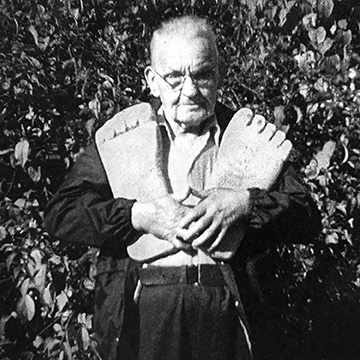
Toledo's Rant Mullins sculpted large feet out of alder to scare berry pickers. File photo.
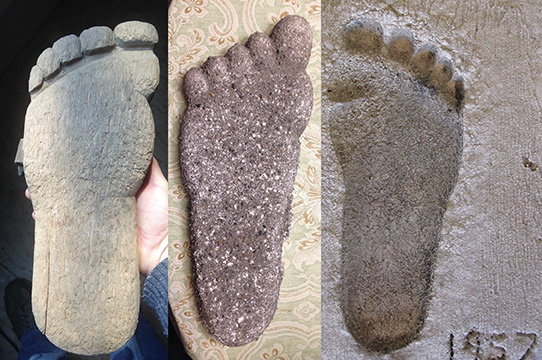
No two footprints are identical but they are quite similar in size and appearance. Photos by Jake Morgan
A Legendary Prankster
Ray Wallace was a hard-working family man who grew up in Toledo and had been an aircraft gunner in World War II. His close friends said Ray was known for doing harmless pranks for fun, like dropping a firecracker down a chimney to scare his friends after a long day of working in the woods.
“These guys would come in to the camp at night and would be sitting by the stove playing cards and Dad would go up on the roof,” Mike said. “He’d get one of those M-80s, he’d wrap it in wet newspaper with a long fuse so it wouldn’t go off right away and he’d drop it down the chimney into the stove. Then he’d come in and sit down with everyone at the card table and a few minutes later, BOOM! The lids would fly off the stove.”
Ray would act surprised and say it must be the firewood, Mike said, adding that Ray would never confess to doing any of his pranks.
So when the Bigfoot story broke, “he just ran with it,” Mike said. “It was a great opportunity to have a ball. He would select people – cousins and relatives who were working for him – and they'd get in on it together. Those guys didn't have television in those days so they made their own fun. They weren’t hurting anyone. They were flat out having a ball and laughing. We’re still laughing.”
Don Buswell still recalls helping Ray make tracks in the thick dust by strapping the wooden feet over his boots.
“The dust was so thick in Northern California it ran like water down the road,” Buswell said, adding that it didn't rain from April to Thanksgiving. “I put the feet on and then I hung on to the back of his pickup and we went real slow down this dusty road, taking long steps. I tell you they are eerie even if you make them yourself. You look back and see them and they're kind of weird.”
Buswell recalled one time he and his brother Anor rolled some empty barrels over the hills in Northern California during the Bigfoot sightings of the late 1950s and then saw it reported in the newspaper that they were full barrels, which can weigh more than 500 pounds. People wondered who else but Bigfoot could lift such a huge barrel.
“That’s the way things get exaggerated,” Buswell said.
Even though the newspaper editors said they suspected the footprints were a hoax, the legend of Bigfoot came alive and mysterious footprints began to show up all over the world.
“Ray had a nephew from Arkansas that came to visit for a few weeks and when he went back to Arkansas, Bigfoot showed up there too,” Buswell said.
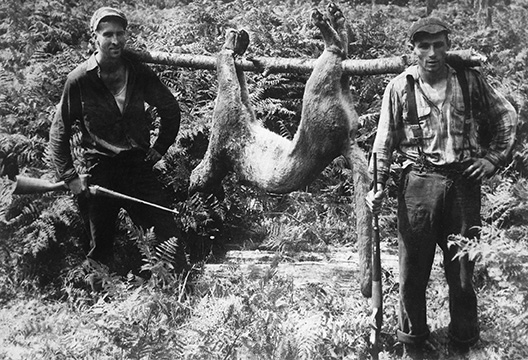
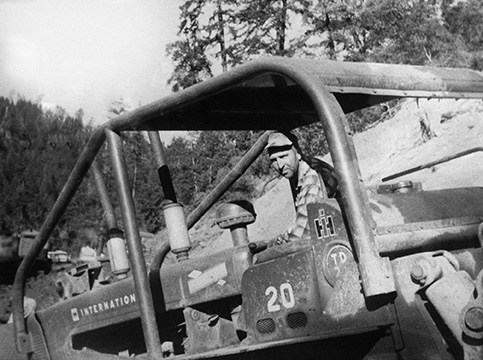
Ray Wallace, left, and Geno Pericone caught cougars and other wildlife in the Pacific Northwest. Wallace spent most of his life working in the woods. Photos courtesy of Mike Wallace.
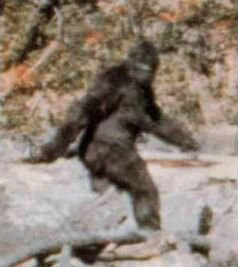
Frame 352 shows a hairy figure looking back.
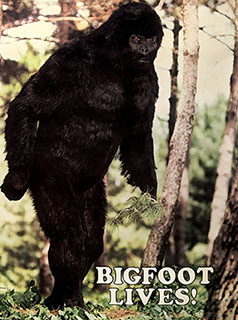
The 1967 Patterson-Gimlin Film
Nine years after the famous footprints were discovered at the Wallace work site in 1958, Bigfoot enthusiast and former cowboy Robert Patterson showed the world the first known film footage of Bigfoot striding across a river bed into the forest. Known as the Patterson-Gimlin film, the grainy, shaky footage lasts less than a minute. The film contains one frame of a hairy biped looking back at the camera that has become the iconic image associated with Bigfoot.
The Toledo Bigfoot group remembers a fellow named Patterson who spent years searching the Willow Creek/Bluff Creek area for signs of Bigfoot.
“Patterson was trying to get the feet (from Ray) all the time,” said Dale Lee Wallace, 85, who also lives in Toledo. Dale Lee was a nephew of Ray Wallace and worked on a lot of the Wallace logging jobs in the late 1950s and early 1960s. He said Patterson was obsessed with finding evidence of Bigfoot. “Patterson went up Bluff Creek trying to find Bigfoot. He brought some mules down there and he went right past us where we was working on Red Creek. We was all laughing at him, calling him crazy.”
Mike said his dad Ray spent a lot of time feeding Bigfoot stories to Patterson but stopped once he realized Patterson’s motives were for profit and not just for fun.
“Patterson was in it for money,” Dale Lee Wallace said. “He was going to make a big movie and he was always trying to get more information from Ray, but Ray wouldn't give it to him. Ray didn't want to tell the truth about it.”
Robert Patterson died in 1972 but his short film remains a cult classic that has inspired a cottage industry of books, movies and Sasquatch merchandise for more than 50 years.
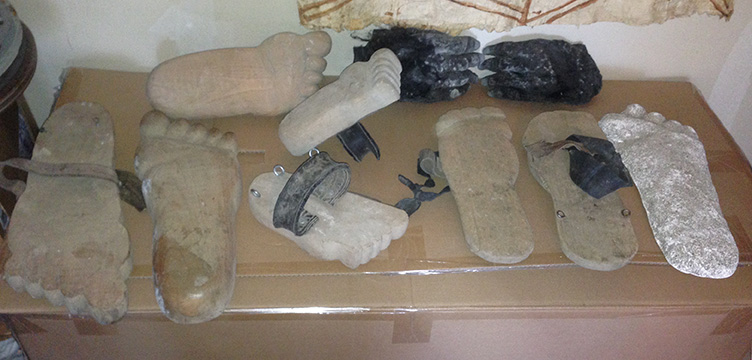
This collection of large, wooden feet was found in Wallace's basement after his death. Courtesy of the Wallace family.
Carved Feet Discovered in Wallace’s Basement
Ray Wallace delighted in spinning Bigfoot tales to his grandchildren and to almost anyone who would listen, but when confronted by skeptics, he would vehemently deny being involved with any kind of a hoax.
When Ray died in 2002 at the age of 84, his family cleaned out his basement and found a sack containing multiple pairs of hand-carved wooden feet complete with leather buckles that fit over shoes. The biggest feet are between 16 to 18 inches long and bear an uncanny resemblance to many of the famous plaster footprint casts.
The Wallace family decided it was finally time to go public with the Bigfoot story.
“After Dad died, we didn't have time to grieve,” Mike Wallace said. “There were hundreds of calls from newspapers and radio and television stations. Sometimes when you're a kid you don't appreciate your parents. After he died, I think I got to appreciate my dad.”
Mike called his dad “cool crazy” and described how Ray was fascinated by UFOs, digging gold mines and searching for oil wells. “From daylight to dark. For a guy with an eighth-grade education he was pretty smart. It's funny how people in Toledo either loved him or thought he was a nut bag. There's no in-between.”
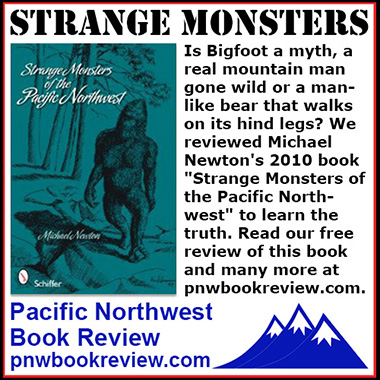
When Ray got too old to stomp around the woods making footprints, he tried making his own 16mm Bigfoot movies by dressing up his friends and family members in a gorilla suit, and he even helped produce a 1971 country album in Nashville called “Bigfoot: Northwest’s Abominable Snowman,” featuring singer Don Jones.
Wallace said Toledo’s part in the Bigfoot saga was these young guys who kept themselves entertained by
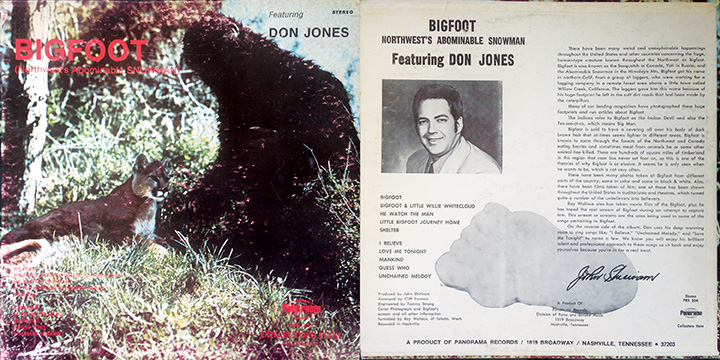
inventing creative pranks, and once it got going “there was no stopping it.” Maybe they took the prank a little too far at times but it’s hard to tell how people will respond to a joke.
Dale Lee Wallace remembers one time in the late 1950s, the Wallace Brothers cleared a flat part of the forest near Weitchpec in Humboldt County to park the trailers for the people who were working for them and apparently the dusty ground was too tempting of an opportunity to pass up.
“Ray put them feet on and walked around the trailers at night and looked in the windows,” Dale Lee said. “The women came out the next morning and seen them big footprints and it just scared them to death. Ray got scared to tell the truth because he figured they’d be madder than hell at him. Ray said, ‘Now don’t be telling anyone that, you damn fool, you’ll get me in trouble.’”
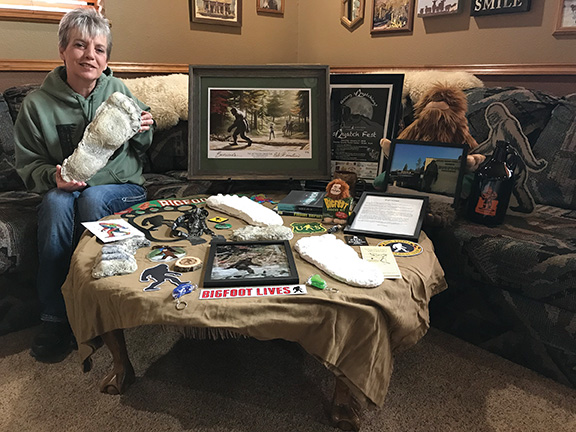
Darlene Masters of Toledo loves anything to do with Bigfoot.
Bigfoot Lives
Pranks aside, the possible existence of large creatures in the wild that haven’t been discovered and documented is exciting to Bigfoot believers and skeptics alike. The small town of Willow Creek, Calif., has a Bigfoot-themed museum, bookstore and steakhouse as well as colorful murals and larger-than-life sculptures.
“Those people are really into it. They believe,” said Toledo resident Darlene Masters, who visited Willow Creek last September to celebrate the 50th anniversary of the Patterson film. She and her husband Ken drove far up into the mountains to see if they could spot the legend.
“I said ‘let me get out and do some calls,’” Masters said. “Ken was laughing at me the whole time and I was kind of joking around, too. I made some whooping noises in this canyon over the woods. I didn't see him, I didn't hear him, but I had fun looking for him.”
Masters said she first became interested in Bigfoot after attending the camp Cispus Learning Center in the Gifford Pinchot National Forest in the 1970s. She has a growing collection of Bigfoot memorabilia including books, sculptures, paintings, stuffed animals and certified plaster footprint casts, and she recently attended sQuatch Fest in Longview, Wash.
“I've never seen so much Bigfoot stuff in my life,” she said about the January festival’s notable guest speakers and approximately 1,500 attendees. “Man it was just packed in there. I had a hard time moving around. I didn't think it was that big of a deal at first but now I want to go again.”
There are hundreds of published books about Bigfoot and Sasquatch, dozens of films and documentaries, countless websites, blogs, Bigfoot-themed merchandise and even professional Bigfoot field guides who offer research expeditions for those looking for a more immersive experience.
“Some people have made lives out of this,” Mike Wallace said. “We’re not trying to hurt those people. The world believed in Bigfoot because they wanted to believe. It really made it easy to pique people's interest.”
Wallace said he was looking through one such book where the author diligently recorded the dates and locations of reported Bigfoot sightings and it occurred to him that many of those records perfectly coincided with the dates and locations of logging and construction jobs by Toledo’s Wallace and Buswell families.
“We're not here to disprove yetis or Sasquatch or the abominable snowman,” Mike Wallace said. “We're just telling you we know who Bigfoot is, and Bigfoot is Ray L. Wallace.”
Copyright © 2026 Lewis County Tribune. All rights reserved.
P.O. Box 550, Toledo, Washington 98591
Contact us or send a news tip to editor@lewiscountytribune.com.
Site designed and powered by Morgan Online Media LLC.

